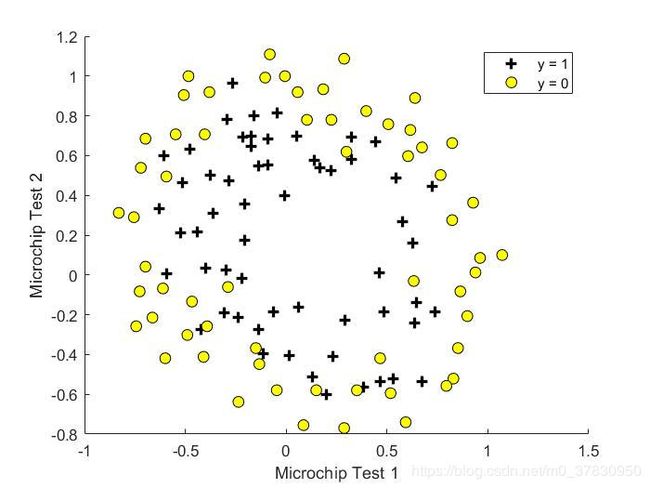吴恩达机器学习课后作业深度解析(附答案)(ex2)
作业ex2题目及答案源码下载地址ex2题目及答案
一、逻辑回归
问题背景,根据学生两门课的成绩和是否入学的数据,预测学生能否顺利入学
- plotData.m:数据可视化
% Find Indices of Positive and Negative Examples
pos = find(y == 1); neg = find(y == 0);
% Plot Examples
plot(X(pos, 1), X(pos, 2), 'k+','LineWidth', 2, 'MarkerSize', 7);
plot(X(neg, 1), X(neg, 2), 'ko', 'MarkerFaceColor', 'y','MarkerSize', 7);
matlab中find函数返回索引列表,详见Matlab 之 find()函数

- sigmoid.m:完成sigmoid函数
g ( z ) = 1 1 + e − z g(z)=\frac{1}{1+e^{-z}} g(z)=1+e−z1
g = 1 ./ ( 1 + exp(-z) ) ;
hypothesis函数定义为
h θ ( x ) = g ( θ T x ) h_\theta(x)=g(\theta^T x) hθ(x)=g(θTx)
- costFunction.m:计算代价和梯度
逻辑回归似然函数取对数为(详见视频课程)
l ( θ ) = ∑ i = 1 m [ y ( i ) l o g h θ ( x ( i ) ) + ( 1 − y ( i ) ) l o g ( 1 − h θ ( x ( i ) ) ) ] l(\theta)=\sum_{i=1}^m[y^{(i)}logh_\theta(x^{(i)})+(1-y^{(i)})log(1-h_\theta(x^{(i)}))] l(θ)=i=1∑m[y(i)loghθ(x(i))+(1−y(i))log(1−hθ(x(i)))]
要想取得最大似然估计,可令代价函数为
J ( θ ) = − 1 m l ( θ ) = 1 m ∑ i = 1 m [ − y ( i ) l o g h θ ( x ( i ) ) − ( 1 − y ( i ) ) l o g ( 1 − h θ ( x ( i ) ) ) ] J(\theta)=-\frac{1}{m}l(\theta)=\frac{1}{m}\sum_{i=1}^m[-y^{(i)}logh_\theta(x^{(i)})-(1-y^{(i)})log(1-h_\theta(x^{(i)}))] J(θ)=−m1l(θ)=m1i=1∑m[−y(i)loghθ(x(i))−(1−y(i))log(1−hθ(x(i)))]
求导得
∂ ∂ θ j J ( θ ) = 1 m ∑ i = 1 m ( h θ ( x ( i ) ) − y ( i ) ) x j ( i ) \frac{\partial}{\partial{\theta_j} }J(\theta)=\frac{1}{m}\sum_{i=1}^m(h_\theta(x^{(i)})-y^{(i)})x^{(i)}_j ∂θj∂J(θ)=m1i=1∑m(hθ(x(i))−y(i))xj(i)
J= -1 * sum( y .* log( sigmoid(X*theta) )
+ (1 - y ) .* log( (1 - sigmoid(X*theta)) ) ) / m ;
grad = ( X' * (sigmoid(X*theta) - y ) )/ m ;
- 利用fminunc函数求得最小代价
options = optimset('GradObj', 'on', 'MaxIter', 400);
[theta, cost] = fminunc(@(t)(costFunction(t, X, y)), initial_theta, options);
其中,GradObj:On 表示使用自己的梯度公式,Maxlter:400表示最大迭代次数。costFunction函数完整形式为function [J, grad] = costFunction(theta, X, y)。
该函数作用是求函数的最小值,代价函数虽然复杂,但是xy等数据是已知的,未知的只有 θ \theta θ的分量,这就相当于几元一次函数的求最值问题。
- plotDecisionBoundary.m:画决策边界

这里只考虑本题的输入 ( 1 , x 2 , x 3 ) (1,x_2,x_3) (1,x2,x3),sigmoid函数的分界点是 z = 0 z=0 z=0,即
θ T x = θ 1 + θ 2 x 2 + θ 3 x 3 = 0 \theta^Tx=\theta_1+\theta_2 x_2 +\theta_3 x_3=0 θTx=θ1+θ2x2+θ3x3=0
要画一条直线将平面分开,首先求得 x 2 x_2 x2的最小值和最大值,然后根据上式求得相应的 x 3 x_3 x3,两点确定一条直线。
plot_x = [min(X(:,2))-2, max(X(:,2))+2];
plot_y = (-1./theta(3)).*(theta(2).*plot_x + theta(1));
plot(plot_x, plot_y)
- predict.m:计算模型精确度
根据给定的数据,查看预测值与实际值是否吻合,先计算预测值
k = find(sigmoid( X * theta) >= 0.5 );
p(k)= 1;
与实际值比较,相加除以总数(均值)
mean(double(p == y)) * 100)
二、逻辑回归(多项式回归)
问题背景:根据以往微晶片两项测试和是否合格的数据,进行预测。
- plotData.m:数据可视化

- mapFeature.m: 特征提取
从图中数据分布可以看到,显然不再是线性边界。那么便需要将每个点的特征进一步提取出来。
[ x 1 x 2 ] < = > [ 1 x 1 x 2 x 1 2 x 1 x 2 x 2 2 . . . x 1 5 x 2 x 2 6 ] \left[ \begin{aligned} x_1\\ x_2 \end{aligned} \right] <=> \left[ \begin{aligned} 1\\ x_1\\ x_2\\ x_1^2\\ x_1 x_2\\ x_2^2\\ .\\ .\\ .\\ x_1^5x_2\\ x_2^6 \end{aligned} \right] [x1x2]<=>⎣⎢⎢⎢⎢⎢⎢⎢⎢⎢⎢⎢⎢⎢⎢⎢⎢⎢⎢⎢⎢⎢⎡1x1x2x12x1x2x22...x15x2x26⎦⎥⎥⎥⎥⎥⎥⎥⎥⎥⎥⎥⎥⎥⎥⎥⎥⎥⎥⎥⎥⎥⎤
从二维变换到28维。
degree = 6;
out = ones(size(X1(:,1)));
for i = 1:degree
for j = 0:i
out(:, end+1) = (X1.^(i-j)).*(X2.^j);
end
end
- costFunctionReg.m:计算代价和梯度
为了防止过拟合,采用L2正则化方法,代价函数为
J ( θ ) = 1 m ∑ i = 1 m [ − y ( i ) l o g h θ ( x ( i ) ) − ( 1 − y ( i ) ) l o g ( 1 − h θ ( x ( i ) ) ) ] + λ m ∑ j = 2 n θ j 2 J(\theta)=\frac{1}{m}\sum_{i=1}^m[-y^{(i)}logh_\theta(x^{(i)})-(1-y^{(i)})log(1-h_\theta(x^{(i)}))]+\frac{\lambda}{m}\sum_{j=2}^n \theta_j^2 J(θ)=m1i=1∑m[−y(i)loghθ(x(i))−(1−y(i))log(1−hθ(x(i)))]+mλj=2∑nθj2
注意:第一项 θ 1 \theta_1 θ1不参与正则化
梯度为
∂ ∂ θ 1 J ( θ ) = 1 m ∑ i = 1 m ( h θ ( x ( i ) ) − y ( i ) ) x 1 ( i ) f o r j = 1 ∂ ∂ θ j J ( θ ) = 1 m ∑ i = 1 m ( h θ ( x ( i ) ) − y ( i ) ) x j ( i ) + λ m θ j f o r j ≥ 2 \begin{aligned} \frac{\partial}{\partial{\theta_1} }J(\theta)&=\frac{1}{m}\sum_{i=1}^m(h_\theta(x^{(i)})-y^{(i)})x^{(i)}_1 \qquad \qquad \quad for\quad j=1\\ \frac{\partial}{\partial{\theta_j} }J(\theta)&=\frac{1}{m}\sum_{i=1}^m(h_\theta(x^{(i)})-y^{(i)})x^{(i)}_j+\frac{\lambda}{m}\theta_j \qquad for\quad j\geq2 \end{aligned} ∂θ1∂J(θ)∂θj∂J(θ)=m1i=1∑m(hθ(x(i))−y(i))x1(i)forj=1=m1i=1∑m(hθ(x(i))−y(i))xj(i)+mλθjforj≥2
theta_1=[0;theta(2:end)]; % 先把theta(1)拿掉,不参与正则化
J= -1 * sum( y .* log( sigmoid(X*theta) ) + (1 - y )
.* log( (1 - sigmoid(X*theta)) ) ) / m + lambda/(2*m) * theta_1' * theta_1;
grad = ( X' * (sigmoid(X*theta) - y ) )/ m + lambda/m * theta_1;
- 利用fminunc函数求解
- plotDecisionBoundary.m:画决策边界
u = linspace(-1, 1.5, 50);
v = linspace(-1, 1.5, 50);
z = zeros(length(u), length(v));
for i = 1:length(u)
for j = 1:length(v)
z(i,j) = mapFeature(u(i), v(j))*theta;
end
end
z = z'; % important to transpose z before calling contour
contour(u, v, z, [0, 0], 'LineWidth', 2)
这里利用contour函数,[0,0]表示画值为0的等高线,[0,1,2]则表示画值为0,1,2的三条等高线。
